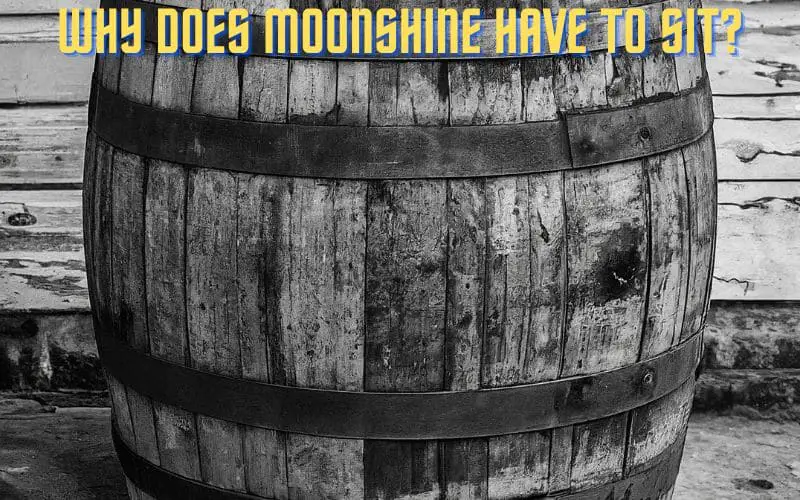Why Does Moonshine Have To Sit? We Find The Answer

Introduction
Welcome to the world of Moonshine! In this article, we will explore the intriguing process of moonshine aging and its effects on flavor. We’ll delve into the science behind moonshine aging, uncover the best practices, and ultimately answer the question: Why does moonshine have to sit? So, grab a jar of your favorite moonshine and let’s embark on this journey together!
Answer to the Question
Moonshine sits to allow chemical reactions to take place, leading to the development of a smoother and more complex flavor. The aging process, whether in oak barrels or other containers, allows the moonshine to mature and enhance its overall quality. Let’s dive deeper into the science behind moonshine aging to understand why this sitting process is crucial.
The Science Behind Moonshine Aging
Chemical Reactions During Aging
During the aging process, chemical reactions occur within the moonshine, leading to the transformation of its flavor profile. Compounds in the moonshine interact with oxygen and other elements, resulting in the development of unique and desirable characteristics.
Oak Barrel Influence on Moonshine
The oak barrel plays a crucial role in moonshine aging. It imparts flavors and compounds to the moonshine, contributing to its rich and smooth taste. The porous nature of the oak allows for gradual oxidation, which further enhances the complexity of the moonshine’s flavor.
- Types of Oak Barrels for Moonshine Aging
- Chemical Reactions with Oak Compounds
- Impact of Charred Oak on Flavor Profile
- Comparison of Different Aging Periods in Oak Barrels
- Environmental Factors Affecting Oak Barrel Influence
Effects of Sitting on Moonshine Flavor
Maturation Process
- Maturation is a crucial stage in the moonshine production process, where the raw, rough spirit is transformed into a refined and complex beverage.
- During maturation, the moonshine interacts with the wooden barrels, absorbing flavors and characteristics that enhance its profile.
- This process leads to the development of depth, smoothness, and a more refined taste, elevating the drinking experience to a superior level.
- The maturation period allows the moonshine to reach its full potential, resulting in an exceptional and satisfying spirit.
Development of Smoothness and Complexity
During the maturation process, the moonshine undergoes a remarkable transformation, leading to the development of its distinctive smoothness and complexity. This period is crucial for enhancing the flavor profile and creating a delightful drinking experience. The following factors contribute to the development of smoothness and complexity:
- Chemical Reactions: Various chemical reactions occur within the moonshine, leading to the formation of new flavor compounds and the breakdown of harsh elements.
- Oak Barrel Influence: The interaction with oak barrels imparts rich flavors, adds depth, and contributes to the overall complexity of the moonshine.
- Integration of Flavors: The sitting period allows the integration of different flavor components, resulting in a multi-dimensional taste experience.
As the moonshine matures, the flavors harmonize, creating a sophisticated taste profile characterized by a captivating interplay of sweet, smoky, and woody notes. The resulting product is a testament to the artistry and patience involved in achieving the perfect balance of smoothness and complexity.
Best Practices for Aging Moonshine
Choosing the Right Aging Container
When it comes to aging moonshine, the choice of aging container plays a crucial role in the overall outcome. Selecting the right aging container is vital to achieving the desired flavor and quality. In this section, we will explore the different types of aging containers, their characteristics, and how they influence the aging process.
There are various types of aging containers available for aging moonshine, each offering unique advantages and considerations. The following are common types of aging containers:
- Oak Barrels: Oak barrels are a popular choice for aging moonshine due to the rich flavors and aromas they impart. They allow the spirit to interact with the wood, leading to complex flavor development.
- Mason Jars: Mason jars are versatile and readily available containers for aging moonshine. They provide a clear view of the aging process and are ideal for smaller batches.
- Stainless Steel Vessels: Stainless steel vessels offer a non-reactive aging environment, preserving the original characteristics of the moonshine without introducing additional flavors from the container.
When choosing the right aging container, several factors should be taken into account to ensure optimal aging results:
- Material: The material of the container influences the interaction between the moonshine and the container, affecting flavor, color, and aroma.
- Size: The size of the aging container impacts the aging process, with smaller containers allowing for faster aging due to increased surface area contact.
- Environment: The storage environment, including temperature and humidity, directly affects the aging process and the final flavor profile of the moonshine.
It’s essential to consider the material, size, and environment when selecting an aging container to achieve optimal aging results.
By understanding the characteristics and considerations of different aging containers, moonshine enthusiasts can make informed choices to enhance the aging process and flavor development.
Storage Conditions
The storage conditions play a crucial role in aging moonshine. Factors such as temperature, humidity, and light exposure impact the aging process and the resulting flavor profile. By maintaining an ideal storage environment, the moonshine can age gracefully and develop nuanced flavors.
Conclusion
In conclusion, the art of moonshine aging is a fascinating journey that unveils the science and artistry behind achieving exceptional flavor. By allowing moonshine to sit and undergo the aging process, we witness the remarkable transformation of its taste, texture, and complexity. The choice of aging container and the meticulous storage conditions are pivotal in shaping the character of the aged moonshine. As we raise our glasses to savor the aged moonshine, let’s appreciate the craft, history, and cultural significance that this timeless tradition encompasses.
